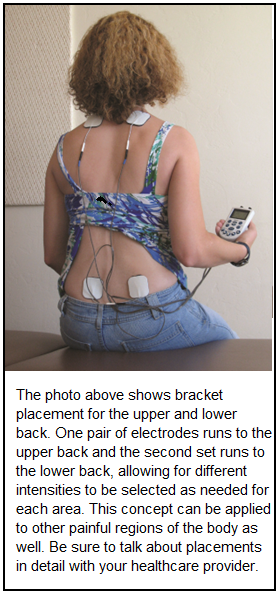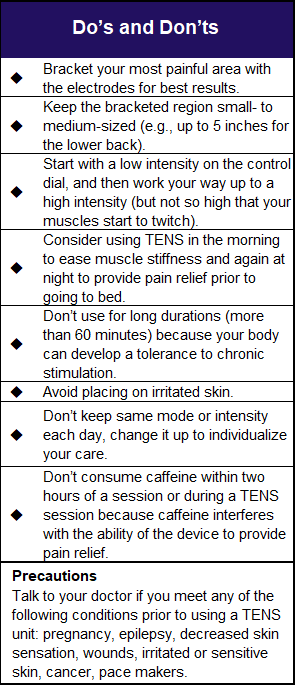Fibromyalgia Basics
TENS for Pain Relief

Looking for a way to get better pain relief without the side effects of drugs? Transcutaneous electrical nerve stimulation or TENS may fill a void in your current treatment program. Several studies show the effectiveness of TENS in different chronic pain conditions, including fibromyalgia. TENS units are small, portable devices that can be used when you need them the most, and purchasing a unit may be an affordable add-on to your fibromyalgia care.
How It Works
TENS units usually have two pairs of electrode pads that are placed on the skin (a mild adhesive is used). The unit generates a tiny electrical current between the two pads and works to reduce the impact of pain-related signals produced by your achy muscles below the surface. In general, these devices prompt the release of your body’s natural endorphins into your spinal cord to relieve pain.
This small hand-held device allows you to control the intensity or strength of the stimulation signal so it should be perceptible (like a tingling sensation), but definitely not painful. Two electrode pads (about one-inch squares) work as a pair to treat one area, so the typical TENS unit with four electrodes allows you to treat two areas at one time. Each pair of electrodes has its own controller to adjust intensity because some places on the body, such as your face and neck, are much more sensitive to the stimulation than your hip or thigh regions.
If you are wondering how treating only two areas at a time could possibly help your widespread pain, keep in mind you can change the locations from day to day. Or if you have the time, you can give yourself more than one treatment session per day. Studies in fibromyalgia patients have shown that treating the most painful area will lead to slight improvements everywhere.1 This means over one or two weeks, you should feel improvements.
Getting Started
Ask your primary care physician or pain specialist if TENS is a possible treatment method for your symptoms. If they don’t use TENS units in their office, they will most likely recommend you see a physical therapist or chiropractor. Your goal should be threefold:
- Be evaluated to determine if TENS is a viable treatment approach for you (i.e., you do not have any contraindications and the stimulation doesn’t bother you).
- Receive education on the proper use of TENS, such as electrode placement and how to set the intensity to get the most benefit while not overstimulating your system.
- Identify a TENS unit that will best suit your needs (you might purchase the unit from the healthcare provider, or they may simply fill out a prescription form for you to purchase one directly online). Typical units range between $40 and $90. If you are not sure you want to fork out this amount money, you may ask your provider if you can take one of their units home for a one-week test period (you will likely incur a rental fee).
Try to avoid several weekly sessions that can be costly if not covered by insurance (one to two visits should suffice). Make sure you voice your goals to the provider on the first visit, so they know what you expect. Don’t assume all providers commonly use TENS for treating fibromyalgia or they have a high level of experience with fibromyalgia. So, call around before you book an appointment.
If you do not have a healthcare provider to assist you with a TENS unit, you can still purchase one without a prescription. Keep in mind that fancy and expensive TENS units are not necessarily better. For your first unit, don’t go overboard on cost. You will probably want to keep it under $100. Also, make sure you can get inexpensive replacement pads and electrodes for the unit (see TENS Resources).
Device Modes
The TENS unit comes with a variety of modes. Some will pulse in a constant rhythm while others will ramp up to a peak intensity and then ramp back down again. When using a TENS unit, you will feel a tingling sensation through the electrodes. The intensity of this sensation is at your control, so you set the comfort level. As an fibromyalgia patient, start with a low intensity first and work your way up to prevent a next day flare. It should not feel like the muscle is twitching or going into a spasm.
Many new versions of the TENS unit come with multiple preset modes (they may have specific settings for the neck, upper shoulders, lower back, hips, etc.). If you purchase a unit with these settings already programmed but some don’t work well for you, your provider can customize the device to your liking. Keep in mind the type of mode and preferred intensity level differs substantially from person to person, so preset units may not be your best option.
A modified type of unit, called interferential current (IFC), generates a more complicated electrical signal that is advertised as being more effective than standard TENS. However, research reports comparing the two types of therapies show both units work equally as well, so there is no need to pay more for an IFC-type device.
What to Expect

Some people only experience relief while the unit is on, while others reap extended benefits. Either way, a TENS unit should help you in the long run, at least if you are in the group that responds to this type of therapy.
“In clinical practice, TENS is usually applied daily over many weeks,” states Richard Leibano, Ph.D., of Brazil.2 “Approximately 30 percent of patients fail to respond to TENS, and of the patients who respond initially, only one-third continue to obtain pain relief after two years.” Of course, these might be better odds than you get from any prescription medication.
Since TENS causes an increased release of pain fighters into your spinal cord, somewhat similar to the action of opioid analgesics, habituation is common. However, studies show that if the TENS sensation fades over the course of a 20- to 40-minute treatment session, the effectiveness of the therapy can be maintained by gradually increasing the intensity setting. You need to continue to feel a tingling sensation for it to work, and the adjustment needed is small (about 10 percent).3
A review of multiple TENS trials in fibromyalgia patients shows that repeat use of this device daily for ten or more sessions using the highest tolerable intensity produced a significant reduction in pain.4 Another study looked at the impact of people taking an opioid on the effectiveness of TENS, and found this drug did not interfere with the device’s ability to provide pain relief.5 They also found that 44 percent of fibromyalgia patients responded with a one-third reduction in pain.
TENS Resource
Reviews with links to buy units:
| Money Best TENS for Your Money |
| Medical News Today 9 Best Units |
| Tens Units Website www.tensunits.com |
| Disclaimer: Consult your doctor before using TENS as an addition to your treatment strategy |
1. Affaitati G, et al. Eur J Pain 15:61-9, 2011.
2. Liebano RE, et al. PAIN 152:335-42, 2011.
3. Pantaleao MA, et al. J Pain 12:581-90, 2011.
4. Amer-Cuenca JJ, et al. PAIN 164(8):1645-57, 2023.
5. Dailey DL, et al. J Pain 7(7):1268-81, 2022.
